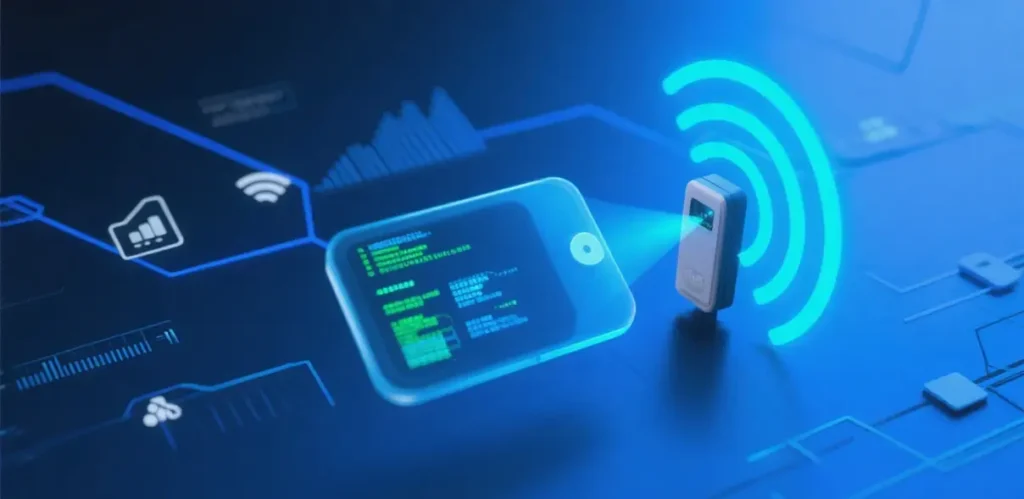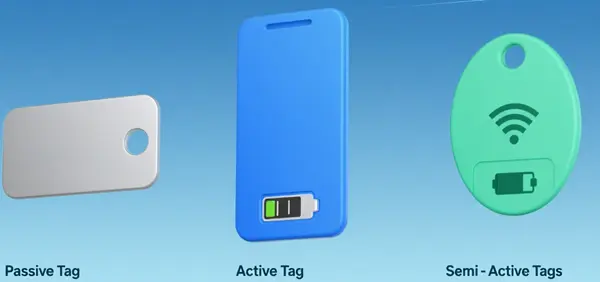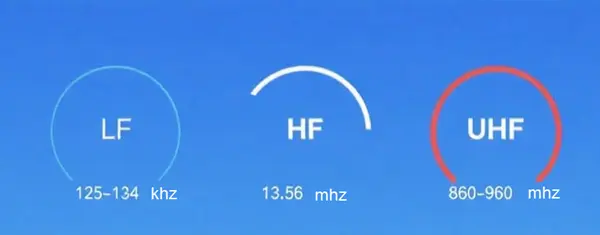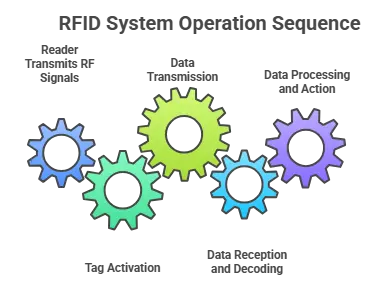
Understanding RFID Systems: How RFID Works
Custom Your RFID Cards
What is RFID?
RFID (Radio Frequency Identification) is a technology that uses radio waves to automatically identify and track objects. It has been widely adopted across numerous fields in modern society. Whether in commercial retail, logistics and transportation, industrial production, or public management, RFID technology provides strong support for efficient operations across industries with its unique advantages.
The importance of RFID technology is self-evident. It not only improves work efficiency and helps reduce costs, but also enhances data management capabilities, providing reliable data support for business decision-making. Here in this article we will provide a detailed analysis and discussion of RFID’s working principles, components, applications, and future trends, giving you a comprehensive and clear understanding of RFID.
Overview of RFID Systems
The core working principle of an RFID system is that tags communicate with readers via radio signals to transmit the unique identification data stored within the tags. When the reader emits a radio signal, tags within its signal coverage range receive it and then send back their identification data containing the unique information of the object, to the reader, thereby achieving object identification.

Compared to similar technologies, RFID is more efficient than barcodes (no line of sight needed, working even with obscured tags) and has wider, more flexible coverage than NFC (ranging from centimeters to tens of meters vs. NFC’s few centimeters).
Core Components of an RFID System
RFID system mainly includes RFID tags, RFID readers, RFID antennas, and host computer systems/software. These components do not operate independently but work together to form a complete identification chain, enabling precise identification and dynamic tracking of objects.
RFID Tags
As the information carrier of the RFID system, tags are electronic devices attached to the objects being identified. They store the unique identification information of the objects and serve as the foundation for identification functionality.
Types
- Passive Tags: These tags have no built-in power source and rely on signals emitted by the reader to obtain energy. They are cost-effective and widely used, making them the most common type of tag in everyday scenarios.
- Active Tags: Equipped with a battery that can actively transmit signals, they have a much longer read/write range than passive tags, making them suitable for long-distance tracking of high-value assets, though they are relatively more expensive.
- Semi-Active Tags: Combine the advantages of the first two types, using a battery to power the internal circuitry and activating data transmission by receiving signals from the reader, achieving a balance between cost and performance.

Tags with Different Frequency
- Low Frequency (LF, 125-134 kHz): Short identification range (<1 meter), strong anti-interference capability, suitable for animal traceability, access control cards, and other close-range scenarios.
- High Frequency (HF, 13.56 MHz): Moderate identification range (<1.5 meters), high data transmission rate, widely used in payment cards, library lending management, and other fields.
- Ultra-High Frequency (UHF, 860-960 MHz): Identification range up to 15 meters and capable of reading multiple tags simultaneously, making it a core choice for logistics sorting and retail inventory management.

RFID Readers
RFID readers act as an “intermediary,” capable of transmitting signals to activate tags and receiving data returned by tags. There are 2 types:
- Fixed Reader: Installed at specific locations, it enables continuous automatic identification of passing objects, suitable for high-frequency, fixed-scenario batch processing.
- Handheld Readers: Portable, allowing operators to move freely while holding the device, suitable for inventory counting, asset inspections, and other scenarios requiring on-site mobile operations.
Communication Principle
The reader transmits radio signals at a specific frequency via an antenna. When a tag enters the signal coverage area, it is activated and sends the stored identification data back to the reader. The reader also has anti-collision functionality, enabling it to process signals from multiple tags simultaneously without data confusion.
RFID Antenna
A “signal bridge” between the reader and tag, responsible for transmitting the reader’s radio frequency signals outward and receiving the response signals from the tag. It is the core component ensuring the integrity of the communication link.
Typically, antennas can be integrated inside the reader (e.g., portable handheld devices) or installed as separate components externally (e.g., warehouse shelves, both sides of aisles). Their installation location and angle must be precisely designed based on the identification area’s scope.
RFID Software
RFID software is the core that endows the system with “intelligence.” It is responsible for processing, analyzing, and applying the data collected by the hardware, serving as the critical link between technology and business operations. It features:
- Inventory Management: Real-time synchronization of tag identification data, dynamically updating inventory quantities and location information to achieve precise monitoring of inventory status.
- Asset Tracking: Continuously records the movement trajectories of assets through tag-reader interactions, ensuring transparent and traceable asset locations for efficient allocation.
- Data Integration: Supports integration with mainstream business systems such as ERP (Enterprise Resource Planning) and WMS (Warehouse Management System), enabling cross-platform data sharing and collaboration.
How an RFID System Works
The operation of an RFID system involves a complete process where a tag communicates with a reader via radio frequency signals, and the data is then processed by the host system. Each step is closely interconnected to achieve the identification and management of objects.

- Initiation: The reader transmits radio frequency signals at a specific frequency within its coverage area to prepare for subsequent communication with the tag.
- Tag Activation: When a tag enters the RF signal coverage area emitted by the reader, passive tags receive energy from the signal to activate their internal circuits, while active tags initiate data transmission preparation upon detecting the signal.
- Data Transmission: The activated tag transmits stored data, such as its unique identifier, back to the reader in the form of radio signals.
- Data Reception and Decoding: After receiving the signal transmitted by the tag, the reader processes it, decoding the radio signal into recognizable digital data.
- Data Processing and Action: The decoded data is transmitted to the host system, which analyzes, stores, and applies the data according to pre-set programs and business requirements, such as updating inventory information or tracking asset locations, thereby achieving various management objectives.
RFID Standards
RFID standards are rules ensuring different manufacturers’ RFID devices and systems work together, while standardizing technical use. They’re key to promoting RFID technology.

- ISO/IEC 18000: This is a series of standards established by the International Organization for Standardization (ISO) regarding air interface communication for RFID systems. It covers different frequency ranges and specifies the data exchange protocols between readers and tags, ensuring compatibility among various devices.
- EPCglobal: EPCglobal is dedicated to developing RFID standards based on the Electronic Product Code (EPC), aiming to achieve unique identification and tracking of products worldwide and promote efficient supply chain management.
- GS1: It has established standards for various automatic identification technologies, including RFID. Its standards are widely applied in retail, logistics, and other fields, ensuring the global uniform identification and sharing of product information.
- RAIN RFID: A global standard system based on ultra-high frequency (UHF) RFID technology, aimed at promoting the adoption and application of UHF RFID technology.
- NFC Forum: Although NFC is a specific form of RFID, the standards established by this organization ensure interoperability among NFC devices in close-range applications such as mobile payments and data transmission.
Application Scenarios
RFID plays a vital role in many fields, revolutionizing operations and management across various industries.
- Inventory Management and Supply Chain Tracking: In warehousing, it enables real-time tracking of goods’ quantity and location for swift counts and efficient inbound/outbound processes. In logistics, it supports end-to-end tracking of transported goods with timely status updates. In retail, it helps precisely control inventory to avoid stockouts or overstocking.
- Asset Tracking: RFID tags can be used to track location and usage status in real time, improving asset utilization rates; for recyclable containers, it can effectively track the circulation process, reduce loss rates, and save costs.
- Access Control and Security: RFID technology can enable rapid identity verification and access management for personnel, enhancing security.
- Retail Industry: RFID tags can be used to effectively monitor merchandise, reduce theft, and achieve loss prevention objectives; in smart fitting rooms, they can quickly identify clothing information and provide styling suggestions, enhancing the consumer shopping experience.
- Healthcare: RFID technology enables real-time patient tracking to ensure treatment accuracy and safety, and facilitates quick location of medical equipment, boosting allocation efficiency and ensuring smooth medical operations.
- Other Related Applications: In sports events, it can be used for precise timing to ensure fairness and impartiality; in agriculture, it can identify and trace livestock, facilitating disease prevention and livestock management.

Differences between RFID, barcodes, Bluetooth, and NFC
RFID, barcodes, and NFC are all used for identification, but there are significant differences between them in terms of working principles, performance characteristics, and application scenarios. For a more in-depth understanding of the specific differences between them, please refer to [RFID vs NFC vs Barcode vs Bluetooth].
RFID in the Future
RFID technology has a bright future ahead, continuously expanding into new fields to achieve broader applications and more efficient functionality.
Technological Advancements
- Chip-less RFID cuts costs significantly, expanding its use in cost-sensitive scenarios.
- Integration with 5G and AI boosts real-time data transmission and system intelligence, enabling more precise management and decision-making.
Emerging Fields
- In smart cities, it aids traffic management (precise vehicle ID, intelligent flow control) and real-time monitoring/maintenance of public facilities.
- In healthcare, it enables precise patient tracking (ensuring treatment accuracy) and supports personalized care with data.
- In autonomous driving, it assists vehicle identification, info exchange, and navigation, boosting safety and reliability.
Conclusion
RFID technology plays an irreplaceable role in improving work efficiency, reducing costs, and enhancing data management capabilities. Its versatility makes it a key technology across various industries.
Looking ahead, RFID technology will keep innovating, with integration into emerging technologies expanding its applications. As it matures and costs drop, it will unlock huge potential across more fields, supporting societal progress. If you have any question about RFID, please contact our experts.


